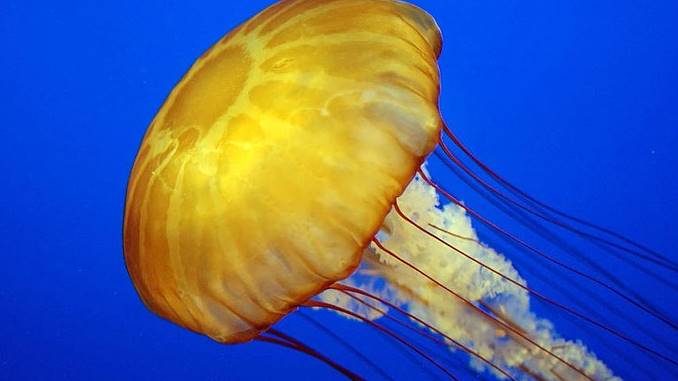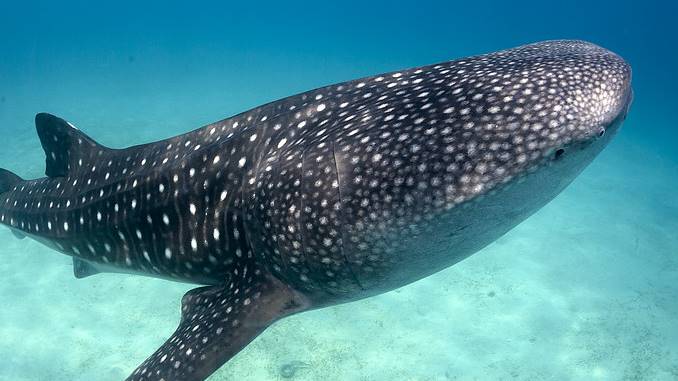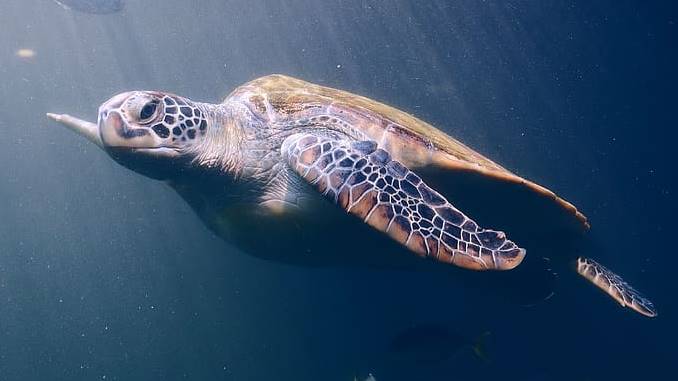Disclaimer: The information presented below is for general informational & educational purposes only. Always consult with animal professionals in case of specific concerns.
Jellyfish can make a wonderful delicacy for humans and other creatures. So, what eats jellyfish?
This is a question many people are interested in.
The most powerful jellyfish predators include ocean sunfish, sea turtles, and swordfish. Please also note that these sea jellies may eat their fellows.
Here is a rundown of animals that include jellyfish in their daily diets. I will mention the 12 most popular ones right here.
Let’s read on to discover.
What Eats Jellyfish?

Jellyfish must encounter threats every day because of their numerous predators, such as turtles, seabirds, crabs, ocean sunfish, whales, and more.
Bearded Goby
These small fish, which are about six inches long, play an important role in their native ecosystem off the coast of Africa.
The African coastline used to be biodiverse until the decades of overfishing. Jellyfish populations boomed as a result of this.
Many scientists believed this issue was a dead end. Fortunately, they found that these gobies had evolved to eat the jellies.
This species helped stabilize the environment, giving optimism for the future of conservation in the area.
Fulmars
Sea birds also like sea jellies as their food. Fulmars, in particular, are among many birds that will gladly swallow any poor sea jelly they come across.
Small creatures such as fish, squid, sea worms, and other small marine animals make up the food of these birds. When carrion flesh is accessible, they will quickly take it.
The birds hunt for prey by rising rapidly high in the air. They then swoop for the poor fish, or in this case, the sea jelly.
Jellyfish
Jellyfish are available in approximately 2000 different species across the world. They aren’t picky eaters, so they will eat it if they come across another jelly.
Sea jellies do not ambush or attack their prey. They don’t have the mental capacity to take such an activity.
Instead, they grab animals when their stingers touch their food. The stingers paralyze the prey, making it simpler for them to consume.
Read more: Do Jellyfish Make Good Pets?
Whale Sharks
These beautiful giants are among the most powerful animals of our time. They are 48 feet in length for females and 30 feet for males.
Whale sharks are filter feeders. They drink water with their huge jaws and filter foodstuff with their teeth.
Planktons, sea jellies, and krill are among the water animals they consume. They live in tropical seas where people spot them feeding.

Megamouth Sharks
Another animal that the sea jellies should be aware of is the Megamouth Shark, one of the ocean’s most mysterious predators.
The name sounds scary, but this shark is not as frightening as it seems. This plantivore eats mostly on plankton.
The shark scoops up water, plankton, and jellyfish with its big mouth. Then, it uses its sharp teeth to act as a filter, catching food within its mouth.
Megamouth sharks live mainly in tropical areas. They may weigh up to 1,650 pounds and stay deep down.
Tuna
Tuna is a saltwater fish having two dorsal fins on the back. Check it up on the internet, and you will find up to 15 tuna species around the world.
The most popular ones are Yellowfin, Bigeye, Bluefin, and albacore.
Tuna can swim quickly, making it a dangerous predator for many creatures, including jellyfish.
The bluefin tuna can hunt from night until dawn. It’s possibly the most voracious jellyfish hunter.

Penguins
As cute as it may look, the penguin is a dangerous predator among jellies, krill, and other aquatic critters.
These animals mostly live in the Southern Hemisphere. Yet, you can find the Galapagos species around the equator areas.
The white and black traits of the penguin are well-known. It also has flippers that look like those of a bird and help the animal swim.
The Emperor species is the biggest penguin, standing up to one meter tall. However, the smallest can only reach an average height of 13 inches.
Penguins spend half of their life underwater. They catch prey as they swim to their favorite location.
Ocean Sunfish
The ocean sunfish, also called the common mola, is one of the world’s biggest bony fishes.
This species lives in tropical and temperate zones. It’s popular for its gray, rough, and flat body.
The jellyfish is a favorite target of the ocean sunfish, although it also eats crabs, squid, and other small fish.
The ocean sunfish can fight against most predators. However, it cannot beat humans, who see it as a unique delicacy.
Sea Turtles
These turtles can grow up to 9 feet long. They are just a few of the water creatures that actually eat jellyfish.
The sea turtle’s robust shell allows it to catch its prey. Because it is invulnerable to most jellyfish, the poor fish can’t sting them as they often do with other predators.
The eyes of this species are also well-protected, making it unbeatable in jellyfish eyes.
Most sea turtles hunt jellyfish, but the most aggressive jellyfish predator is the leatherback species.
This creature might weigh from 450 to 1,700 pounds as the world’s biggest ocean turtle. This big size scares the prey just by showing up in front of them.
Apart from the leatherback turtles, six other sea turtle species also like sea jellies. They are flatback, Kemp’s ridley, loggerhead, green sea, olive ridley, and hawksbill turtles.

Swordfish
This migratory and carnivorous species, sometimes called the broadbill, live in the Pacific and Atlantic temperate zones.
This species is famous for being elusive as a popular sport fish. You may also appreciate its sharp beak and long body.
The swordfish loses its teeth and scales as an adult. It can grow to be 15 feet long and weigh up to 650 kg.
The swordfish’s speed and agility allow it to grab a jellyfish and other prey. It injures the sea jelly with its sword-like beak, making it immobile and therefore unable to break its grasp.
The swordfish is most active at night when they can search the surface for their meals.
Crabs
Since crabs live at the bottom of the water, they have a lot of trouble getting to jellyfish. They eat mostly dead jellies.
Surprisingly, the jellyfish stinging cells don’t enter or interact with the hard shell and mouthpiece of the crabs.
Related: What Eats Frogs In The Food Chain?
Do Jellyfish Eat Jellyfish?
Yes, it sounds weird, but the bigger ones eat the smaller ones among these jellies.
The jellies eat their fellows the same way they eat their other prey. They use their long arms as trip lines in some way.
When a smaller jelly gets trapped in the line, the predator produces its nematocysts, which cause the trapped fish to get shocked (or even dead).
Then, the predator releases its tentacles to put the meal into its mouth and enjoy its reward.
The swimming style of this species also assists it is grabbing more prey. It takes more water and the marine creatures that go with it as its umbrella-shaped head grows.
The jelly restarts its predatory tactics as soon as the food supply is within sight, no matter if it’s the counterpart.
This video shows you how the sea jelly eats its fellow:
How Do Jellyfish Defend Themselves From Predators?
Stinging tentacles of this creature work as both a defense system and a dangerous weapon for trapping prey.
When the tentacles are near their victim, the nematocysts in tentacles produce filaments and harpoons, which emit toxins that immobilize their prey.
Meanwhile, their oral arms assist in catching and swallowing the caught marine animals.
The stings may be painful and dangerous to humans too. The jellies do not, however, harm people on purpose.
A jellyfish possesses 3 million stingers for every inch of its tentacles. Whenever the stinging cells come into direct contact with our skin, the poison comes out.
Here are some effects of the poison:
- Swelling or skin rash surrounding the affected area;
- Severe aches all over;
- Difficulty in swallowing, breathing, and talking;
- Profuse sweating and shivering;
- Headache, nausea, diarrhea, and vomiting.
Conclusion
So what eats jellyfish?
This species is a great food source for many animals, including marine turtles, sharks, ocean sunfish, tuna, swordfish, and penguins.
Surprisingly for certain sea jellies, their fellow jellies will attack and eat them as long as they are hungry.

Hi, my name is John, and I’m an animal lover. I’ve been fascinated with the animal kingdom since I was 5 years old, and my passion keeps growing bigger as I age. And this blog is where I share my researches and passion with animal lovers all around the world.
